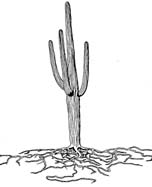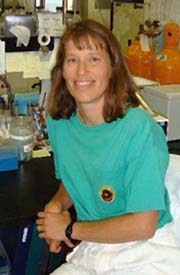 |
DIVISION
OF PLANT PATHOLOGY & MICROBIOLOGY |
|
|
||
|
|
||
|
|
||
| Area of Interest: Dr. Elizabeth (Betsy) Pierson received her Ph.D. in Ecology from Washington State University in 1988. She also has a bachelor's degree in Biology, which she received from Indiana University. She teaches sections of Principles of Plant Microbiology (Plant Disease Epidemiology) and Biology and Characterization of Plant Pathogenic Agents (Plant Pathogenic Bacteria). Her research interests include two areas: microbial ecology (microbe-microbe and microbe-plant interactions, rhizosphere ecology, bacterial biofilms) and terrestrial ecology: (the ecology of native desert plants/impacts of non-native plants). Dr. Pierson spent 4 years conducting field studies of the saguaro in collaboration with botanist Ray Turner while working for the USGS at the Tumamoc Hill Desert Laboratory in Tucson and is the curator for this long term data set. |
||
|
|
||
| Research Goals: The overall goal of our lab is to develop the technology to understand, characterize, visualize and quantify ecological interactions among bacteria in plant-associated biofilm communities. Ultimately, we hope the study of microbial community interactions at population and genetic levels may provide a better understanding of the control points involved in the establishment and dynamics of microbial communities (including biological control) in the rhizosphere. Our work has focused on the ecological significance of molecular signaling via the production of N-acyl-homoserine lactone signals (HSL’s) between bacterial populations on plant roots. This mechanism of cell-cell communication is exciting since it may allow bacterial strains co-inhabiting plant surfaces to influence the outcome of competition by affecting the regulation of physiochemical behaviors at a genetic level. Our model system, Pseudomonas chlororaphis (aureofaciens) strain 30-84, is an effective biological control agent for wheat take-all disease caused by the fungal pathogen Gaeumannomyces graminis var. tritici. This bacterium uses two quorum-sensing (QS) systems that modulate the expression of genes involved in phenazine antibiotic production, exoprotease activity, and cell surface characteristics. Expression of these genes is involved in the ability of a bacterial strain to survive and compete with other microorganisms (including other bacteria and fungal pathogens). We developed a series of mutant and reporter derivatives of strain 30-84 that allow measurement of gene expression in situ. These reporters serve as ‘bacterial biosensors’ that enable quantitative detection of intercellular communication via diffusible signals. Using our reporters, we demonstrated that a subset of the bacteria inhabiting the wheat rhizosphere produce diffusible signals that positively cross communicate with strain 30-84 (e.g. their signals also could activate gene expression in strain 30-84). Subsequently, we discovered a small subset of the population that negatively cross communicate with strain 30-84 (e.g. their signals could down-regulate QS in strain 30-84). We recently found that the two QS regulatory systems and the phenazine antibiotics under QS control also are involved in biofilm formation by strain 30-84. |
||
|
|
||
Selected Publications: VSRK Maddula, Zhang, Z, EA Pierson, and LS. Pierson III. Quorum sensing and phenazines are involved biofilm formation by Pseudomonas chlororaphis (aureofaciens) Strain 30-84. Microbial Ecology (in press, available online). He J, Wijeratne EM, Bashyal BP, Zhan J, Seliga CJ, Liu MX, Pierson EA, Pierson LS 3rd, VanEtten HD, Gunatilaka AA. Dec 2004. Cytotoxic and other metabolites of Aspergillus inhabiting the rhizosphere of Sonoran desert plants. Journal of Natural Products, 67:1985-91. Wijeratne EM, Carbonezi CA, Takahashi JA, Seliga CJ, Turbyville TJ, Pierson EA, Pierson LS 3rd, VanEtten HD, Whitesell L, Bolzani Vda S, Gunatilaka AA. Aug 2004. Isolation, optimization of production and structure-activity relationship studies of monocillin I, the cytotoxic constituent of Paraphaeosphaeria quadriseptata. J Antibiot ( Tokyo), 57:541-6 Morello, JE, EA Pierson, and LS Pierson III. 2004. Negative cross-communication among wheat rhizosphere bacteria: Effect on antibiotic production by the biological control bacterium Pseudomonas aureofaciens 30-84. Applied and Environmental Microbiology, 70(5):3103-9. Loh, J, Pierson, EA, Pierson, LS III, Stacy, G, and A. Chatterjee. 2002. Quorum sensing in plant-associated bacteria. Current Opinion in Plant Biology 5:1-5. Chancey, S. T., D. W. Wood, E. A. Pierson, and L. S. Pierson III. 2002. Survival of GacS/GacA mutants of the biological control bacterium Pseudomonas aureofaciens 30-84 in the wheat rhizosphere. Applied and Environmental Microbiology 68: 3308-3314. Fernandes, J., Brendel, V., Gai, X., Lal,, S., Chandler, V.L., Elumalai, R., Galbraith, D.W., Pierson, E.,and Walbot, V. 2002. Comparison of RNA expression profiles based on maize EST frequency analysis and microarray hybridization. Plant Physiology 128:896-910. Galbraith, D. W.; Macas, J.; Pierson, E. A., Xu, W., and Nouzová, M. 2001. Printing DNA microarrays using the Biomek® Laboratory Automation Workstation. Methods in Molecular Biology (DNA Arrays Methods and Protocols); Rampal, J. B., ed., Humana Press, New Jersey. Pierson, E. A ., D. W. Wood, J. A. Cannon, F. M. Blachere, and L. S. Pierson III. 1998. Interpopulation signaling via N-acyl homoserine lactones among bacteria in the wheat rhizosphere. Molecular Plant Microbe Interactions 11:1078-1084. Pierson, L. S. III, D. W. Wood, and E. A. Pierson. 1998. Homoserine lactone-mediated gene regulation in plant-associated bacteria. Annual Review of Phytopathology 36:207-225. Grebenok, RJ, E Pierson, GM Lambert, FC Gong, CL Afonso, R Haldemanchahill, JC Carrington, DW Galbraith. 1997. Green-fluorescent protein fusions for efficient characterization of nuclear targeting. Plant Journal 11(3):573-586. Pierson III, L. S. and E. A. Pierson. 1996. Phenazine antibiotic production in Pseudomonas aureofaciens: role in rhizosphere ecology and pathogen suppression. FEMS Microbiology Letters 136:101-108. Kim, D. H., I. J. Misaghi and E. A. Pierson. (1996). Fluorescent pseudomonad populations in modified rhizosphere atmosphere. Soil Biology and Biochemistry 28(4):497-501. Pierson, E. A. and D.M. Weller. (1994). The use of bacteria mixtures to improve the effectiveness of biological control of take-all of wheat. Phytopathology 84:940-947. Harrison LA, L Letendre, P Kovacevich, E. A. Pierson, DM Weller, and B Hemming. (1993). Purification of an antibiotic effective against Gaeumannomyces graminis var. tritici produced by a potential biocontrol agent, Pseudomonas aureofaciens. Soil Biology and Biochemistry 25:215-221. Vincent MA, LA Harrison, JM Brackin, PA Kovacevich, P Mukerji, E. A. Pierson, and DM Weller. (1991). Genetic analysis of the antifungal activity of a soilborne Pseudomonas aureofaciens strain. Applied and Environmental Microbiology 57:2928-2934. Ecological Publications: Bowers, J. E. and E. A. Pierson. 2001. Implications of seed size for seedling survival in Carnegiea gigantea and Ferocactus wislizeni (Cactaceae). The Southwestern Naturalist 46(3):272-281. Pierson, E. A. and R. M. Turner. 1998. An 85-yr study of saguaro (Carnegiea gigantea) demography at the Desert Laboratory, Tumamoc Hill. Ecology 79:2676-2693. |
||
|
|
||
| For more information contact:
Dr. Elizabeth Pierson Phone: (520)621-7158 |
||
|
|
||
|
